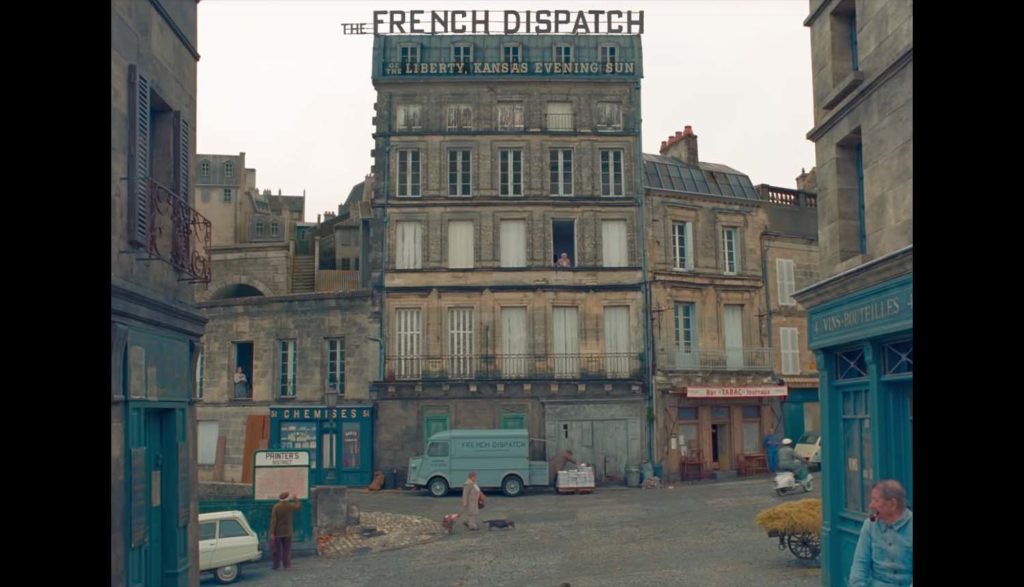
The French Dispatch is the French foreign bureau of Liberty, Kansas’ Evening Sun.
Mr. Arthur Howitzer, Jr., editor of The French Dispatch, moved to France to start the magazine because he was bored with his life on the plains of America’s Midwest. Ironically, the town he relocated to was called Ennui-sur-Blasé, or “Boredom-on-Blasé”.
Over the years, Mr. Howitzer curated some of the best (if somewhat odd) writers in the world. Together, they created articles about “world politics, the arts and diverse stories of human interest.”
But now, Mr. Howitzer is dead. And as a stipulation of his last will and testament, the magazine will shut down. But not before releasing one final issue as a sort of obituary for its beloved editor.
Part of Mr. Howitzer’s decision to move to France was driven by his desire to write and publish whatever he wanted. We see him interact with his writers as an editor, coddling and coaxing them to become better at their craft but also protecting them by refusing to kill any of their stories. It’s clear that the writers are fond of their boss and vice versa.
When a man tries to end his life, his friend stops him. She says she understands his struggles, but she believes he’ll work through it and someday be happy again. And it becomes clear that the man doesn’t truly want to die (he had tried to take his life once before) but that he’s just dissatisfied with his current situation (he’s in prison).
A single father (who is widowed) demonstrates his love for his son by letting the boy help him solve police cases, doing everything he can to rescue his son when the boy is kidnapped and responding to the child’s anger (he slaps his father) by hugging him.
We hear that a woman is reunited with the child she had given away years before.
There is a church in the background of a scene. Several people utter prayers, and we hear an “amen.” Several zealous choir boys are described as “drunk on the blood of Christ.”
A woman with no clothes stands in several strange poses (exposing herself completely) for an artist. Later, we see her and the artist lying next to one another, covered only by sheets (clearly after a sexual interaction). We also learn that the woman refused to marry anyone (she rejects the artist’s proposal) and that she had a child out of wedlock.
A woman walks in on a much younger man bathing. He covers himself with his hands when he exits the tub. Later, we hear a bed squeaking followed by a shot of the pair sitting in a bed together (she is clothed, he is shirtless).
Someone tells a young couple to “go make love” and the woman says she is a virgin, though the man admits he isn’t. We later see them both topless, sitting across from each other before they kiss.
We see a photograph of a nude woman. There is a sculpture of a man’s torso, showing the genitals. We see male and female prostitutes, as well as several scantily clad showgirls. We hear the terms “streetwalkers,” “gigolos,” “pimps” and “floozy.”
People talk about and make comparisons to sex, sometimes crudely. Several male college students protest for the right to access the female students’ dormitories. We learn that a gay man was arrested for “wrong love.” We see a couple kissing in the street.
A man is shot offscreen, and we see his corpse. Police and criminals have shootouts several times, though it appears nobody is hit. Several kidnappers are killed (and we see their bodies) after their food is poisoned. A newsclip shows soldiers fighting in a war. A dead body is pulled from the river. A man stabs himself in the leg.
A man is arrested for assault, battery and violent dismemberment after he kills several people in a bar. We don’t see the attack, other than some blood splattering on the walls. However, we hear that he decapitated two bartenders with a meat saw. And he expresses that he feels no regret or remorse for his actions.
This same man drinks mouthwash in prison in an attempt to fatally poison himself. He also straps himself into an electric chair and asks a prison guard to flip the switch. She obliges, but only for one moment since she doesn’t believe he really wants to die; but she also wants to make sure that he knows how much electrocution hurts so that he won’t try again.
A young man drafted into military service jumps from a window. We don’t see the body, but his friends say he isn’t moving. Another young man is killed after a radio tower he was climbing falls into the river.
During a prison riot, people chase each other with makeshift weapons, and we later learn that several died. Protesting students set up barricades against the police (which are armed in riot gear). The police use tear gas as well as rubber bullets to subdue them.
While being tortured for information, a man gets punched in the stomach, dunked underwater, hung upside down, slid along a table with glassware and thrown from a plane.
In an animated car chase, a man jumps on the hood of a car to try to stop it. He is then thrown through a window when the car screeches to a sudden halt (though he is unharmed). And the car later crashes. A man gets a bloody nose after he is purposely tripped.
We see several dead animals hanging in a butcher’s shop and a chef’s kitchen. Several young boys chase and presumably beat up a bike rider. A boy slaps his father in the face. A man uses chloroform to knock a boy unconscious.
A woman says she was almost raped. We hear that it’s “common” for artists to harm themselves and others for inspiration. People talk about “war wounds.”
There are four uses of the f-word (one preceded by “mother”) and one of the s-word. There are also uses of “a–,” “a–hole,” “h—” and an extremely crude slang term for oral sex. God’s name is misused twice.
People smoke and drink throughout. A few young women addicted to harder drugs are called “junkies.”
Someone uses a public urinal. People steal, lie and manipulate. Several prison guards accept bribes. A boy is criticized for crying after being fired without cause. The body of a heart attack victim lies on a desk.
Wes Anderson has always been one of those directors, in my mind, who toes the line between “artistic genius” and “total whack job.” And The French Dispatch only served to remind me of that.
This is such a strange film that it’s difficult to glean any sort of overarching message from it. Anderson himself admitted that the film was hard to explain in an interview with Charente Libre. But I’ll use his own words: “It’s more of a portrait of this man, of this journalist who struggles to write what he wants to write.”
However, it doesn’t seem as though Anderson had trouble visualizing what he wanted to film. Nudity, swearing, suicide and other forms of violence pervade the film’s creativity.
Fans of literary magazines will probably flock to The French Dispatch since Anderson was inspired by a similar publication. But those who do will find it is filled with foul content posed as artistic expression.


Emily studied film and writing when she was in college. And when she isn’t being way too competitive while playing board games, she enjoys food, sleep, and geeking out with her husband indulging in their “nerdoms,” which is the collective fan cultures of everything they love, such as Star Wars, Star Trek, Stargate and Lord of the Rings.